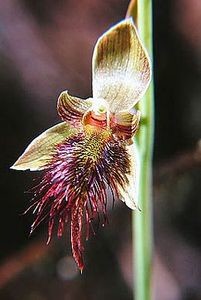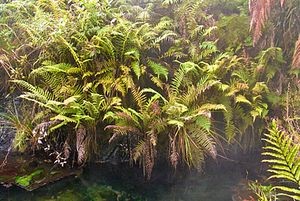 Bearded orchid (Calochilus robertsonii) is commonly found in geothermal areas. Photo: Ian St George
Bearded orchid (Calochilus robertsonii) is commonly found in geothermal areas. Photo: Ian St George Prostrate kanuka (Kunzea ericoides var. microflora) at Craters of the Moon. Photo: Chris Bycroft.
Prostrate kanuka (Kunzea ericoides var. microflora) at Craters of the Moon. Photo: Chris Bycroft. Undescribed species of Christella at Kuirau Park, Rotorua. Photo: Chris Bycroft.The varied nature of geothermal environments, due to varying combinations of temperature, chemistry, hydrology, and localised protection from frosts, produces rare and unusual habitats for plants. Based on species distributions, the following groups of plants are characteristic of geothermal sites:
Undescribed species of Christella at Kuirau Park, Rotorua. Photo: Chris Bycroft.The varied nature of geothermal environments, due to varying combinations of temperature, chemistry, hydrology, and localised protection from frosts, produces rare and unusual habitats for plants. Based on species distributions, the following groups of plants are characteristic of geothermal sites:
- Plants of geothermal habitats are able to tolerate conditions within geothermal habitats, but may also occur in neighbouring non-geothermal vegetation. Examples of such species include manuka (Leptospermum scoparium subsp. scoparium), mingimingi (Leucopogon fasciculatus), monoao (Dracophyllum subulatum), and NZ blueberry (Dianella nigra).
- Another group of plants have established into geothermal sites as they mimic aspects of its usual habitats (Given 1995); for example outside their normal latitudinal and altitudinal range. Some species are found in warmer climates outside New Zealand, but within New Zealand are only located at geothermal sites. Examples of these species are the ferns Nephrolepis flexuosa and Dicranopteris linearis var linearis. Others species occur at higher altitudes in geothermal areas than its normal range, including the ferns Thelypteris confluens and Cyclosorus interruptus and the clubmoss Lycopodiella cernua. Many of these species are frost-intolerant and conditions such as steam and heated soils protect them from these cold events.
- One of the most interesting geothermal species of geothermal habitat in New Zealand is the woody shrub prostrate kanuka Kunzea ericoides var. microflora). Prostrate kanuka is of particular interest as it is endemic to New Zealand, where it is only occurs in geothermal habitats. The form of the plant varies in relation to soil temperatures, becoming shorter in stature as soil temperatures increase. There has been scientific interest in prostrate kanuka’s ectomycorrhizal association with the fungus Pisolithus.
Threatened and At Risk Plants
The following threatened and at risk plant species are known from geothermal sites in New Zealand.
Threatened - Nationally Critical
Sullivania minor (flying duck orchid)
Threatened - Nationally vulnerable
At Risk -Declining
Christella undescribed sp. of thermal sites
Cyclosorus interruptus
Dianella haematica
Nephrolepis flexuosa
Thelypteris confluens
At Risk - Naturally Uncommon
Calochilus paludosus
Calochilus robertsonii
Dicranopteris linearis var. linearis
Fimbristylis velata
Hypolepis dicksonioides
Korthalsella salicornioides
Kunzea ericoides var. microflora
Petalochilus alatus
Schizaea dichotoma
For more information see:
- Given D.R. 1995: Geothermal Vegetation - an assessment of botanical values of selected geothermal sites in the Taupo Volcanic Zone. David Given and Associates, Christchurch.
*The Network is not responsible for the content of external internet sites
